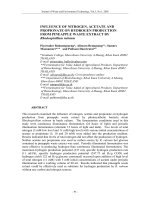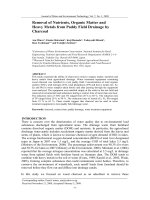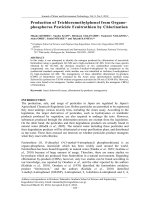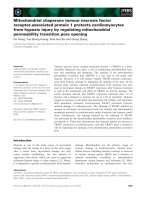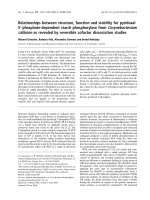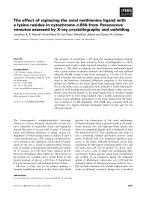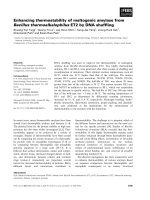Simvastatin protects heart from pressure overload injury by inhibiting excessive autophagy
Bạn đang xem bản rút gọn của tài liệu. Xem và tải ngay bản đầy đủ của tài liệu tại đây (1.08 MB, 9 trang )
Int. J. Med. Sci. 2018, Vol. 15
Ivyspring
International Publisher
1508
International Journal of Medical Sciences
2018; 15(13): 1508-1516. doi: 10.7150/ijms.28106
Research Paper
Simvastatin Protects Heart from Pressure Overload
Injury by Inhibiting Excessive Autophagy
Feifei Su1*, Miaoqian Shi2*, Jian Zhang3*, Qiangsun Zheng4, Dongwei Zhang1, Wei Zhang1, Haichang
Wang1, Xue Li1
1.
2.
3.
4.
Department of Cardiology, Tangdu Hospital, Fourth Military Medical University, Xi’an, 710038, China.
Department of Cardiology, PLA Army General Hospital, No.5 Nanmen Cang, Dongcheng District, Beijing, 100700, China.
Department of Cardiology, Beijing Chest Hospital Heart Center, Capital Medical University, No.9. Beiguan Grand Street, Tongzhou District, Beijing, 101149,
China.
Division of Cardiology, Second Affiliated Hospital of JiaoTong University, Xi’an, 710004, China.
* These authors contributed equally to this work.
Corresponding author: Feifei Su, Department of Cardiology, Tangdu Hospital, Fourth Military Medical University, Xi'an, 710038, China. Telephone: +86 29
84777722; Email:
© Ivyspring International Publisher. This is an open access article distributed under the terms of the Creative Commons Attribution (CC BY-NC) license
( See for full terms and conditions.
Received: 2018.06.25; Accepted: 2018.08.29; Published: 2018.10.20
Abstract
Cardiac hypertrophy is an independent predictor of cardiovascular morbidity and mortality. To
identify the mechanisms by which simvastatin inhibits cardiac hypertrophy induced by pressure
overload, we determined effects of simvastatin on 14-3-3 protein expression and autophagic
activity. Simvastatin was administered intragastrically to Sprague-Dawley (SD) rats before
abdominal aortic banding (AAB). Neonatal rat cardiomyocytes (NRCs) were treated with
simvastatin before angiotensin II (AngII) stimulation. 14-3-3, LC3, and p62 protein levels were
determined by western blot. Autophagy was also measured by the double-labeled red
fluorescent protein-green fluorescent protein autophagy reporter system. Simvastatin
alleviated excessive autophagy, characterized by a high LC3II/LC3I ratio and low level of p62,
and blunted cardiac hypertrophy while increasing 14-3-3 protein expression in rats that had
undergone AAB. In addition, it increased 14-3-3 expression and inhibited excessive autophagy
in NRCs exposed to AngII. Our study demonstrated that simvastatin may inhibit excessive
autophagy, increase 14-3-3 expression, and finally exert beneficial effects on cardioprotection
against pressure overload.
Key words: 14-3-3, autophagy, hydroxymethylglutaryl-CoA reductase inhibitors, simvastatin, hypertrophy
Introduction
Autophagy is a catabolic process that degrades
damaged cellular proteins and organelles. It is
essential for maintaining cellular homeostasis[1].
However, prolonged and excessive autophagy is
maladaptive and can result in cell death[2].
Hypertrophic cardiomyocyte growth and dysfunction
are associated with various forms of heart diseases,
such as hypertension and coronary heart disease[3, 4].
Recently, accumulating evidence has revealed a tight
link between cardiomyocyte autophagy and cardiac
hypertrophy[5]. Excessive autophagy can occur in
hypertrophied cardiac myocytes[6]. Thus, therapeutic
strategies targeting autophagy for cardiac hypertrophy are attractive.
Hydroxymethylglutaryl coenzyme A reductase
inhibitors (statins) have been shown to reduce
cardiovascular-related mobility and mortality
independently of their cholesterol-lowering function
[7]. Simvastatin, a statin, has been shown to have
pleiotropic effects, such as reducing cardiac
hypertrophy [8, 9]. However, the effects of
simvastatin on autophagy in the hypertrophied heart
have not been clearly documented thus far.
Members of the 14-3-3 protein family regulate
Int. J. Med. Sci. 2018, Vol. 15
signal transduction, apoptosis, and checkpoint control
pathways[10]. These proteins have been shown to
modulate autophagy in cancers[11-13]. Recently,
14-3-3 proteins were indicated to play important roles
in cardiomyocytes. Dominant-negative 14-3-3
promotes cardiac apoptosis [14]. 14-3-3 protects
against diabetic cardiomyopathy [15]. Additionally,
the 14-3-3γ protein attenuates lipopolysaccharideinduced cardiomyocyte injury through the Bcl-2
family pathway[16] and has a protective role against
mitochondrion-mediated cardiomyocyte apoptosis
[17]. Most previous studies were focused on the role
of 14-3-3 in the diabetic heart, and less attention has
been paid to the effects of the protein on cardiac
hypertrophy.
Therefore, we hypothesized that simvastatin
might prevent cardiomyocyte hypertrophy by
regulating 14-3-3 and autophagy. To test the
hypothesis, we used an in vitro model of angiotensin II
(AngII)-induced
neonatal
rat
ventricular
cardiomyocytes (NRCs) and an in vivo model of
abdominal aortic banding (AAB)-induced heart
hypertrophy. We found that simvastatin partially
reversed cardiomyocyte hypertrophy by regulating
autophagy and 14-3-3 protein expression.
Materials and Methods
Ethical approval of the present study protocol
The experimental protocol was implemented
according to the tenets of the Declaration of Helsinki
and the procedures involving animals were approved
by the Animal Care and Welfare Ethics Committee of
the Fourth Military Medical University (FMMU,
Xi’an, China).
AAB surgical procedures
Male Sprague-Dawley (SD) rats were purchased
from the Animal Center of the FMMU. Simvastatin
was purchased from Merck, Sharp & Dohme Inc.
Other chemicals were of laboratory grade. Forty rats
(weight, 180-220 g; age, 9-12 weeks) were divided into
four groups (n = 10): SHAM group, comprising rats in
which surgery was performed without banding of the
aorta; SHAM+SIM group, comprising SHAM rats
treated with simvastatin (40 mg/kg·day); AAB group,
comprising rats in which AAB was performed; and
AAB+SIM group, comprising AAB rats treated with
simvastatin 1 day before the AAB procedure. AAB
was performed as previously described with minor
modifications[18]. All rats were anesthetized with an
intraperitoneal injection of 45 mg/kg pentobarbital
sodium. In brief, after anesthetization, the rats were
restrained and a midline abdominal incision was
made under sterile conditions. The abdominal aorta
above the renal arteries was dissected. A ligature (4-0
1509
silk sutures) was positioned around the aorta along
with a blunt 22-gauge needle, which was then
withdrawn, leading to constriction (approximately
50%) of the aorta. After surgery, each rat received 30
kU penicillin intramuscularly as antibiotic therapy.
Simvastatin was dissolved in 0.9% saline solution. The
rats received placebo (0.9% saline solution) or
simvastatin intragastrically every day for 7 weeks
before surgery.
M-mode echocardiography and left
ventricular-weight index measurements
Echocardiograms were performed by Dr.
Yunyan Duan (Department of Ultrasonography,
Xijing Hospital, Xi’an, China) as previously reported
[9, 19]. In brief, the rats were anesthetized as
previously described with an intraperitoneal injection
of 45 mg/kg pentobarbital sodium. A 2-D axis view of
the left ventricle was obtained with a 7.5-MHz
transducer and the M-mode tracings were then
recorded to measure the indexes of the left ventricle:
left ventricular posterior wall thickness of diastasis
(LVPWTd) and interventricular septal thickness of
diastasis (IVSTd). The hearts of the rats were removed
and the left ventricles were dissected. The left
ventricle was weighed and divided by body weight in
order to calculate the left ventricle weight index
(LVWI).
Isolation of adult rat ventricular
cardiomyocytes
Adult rat ventricular cardiomyocytes were
isolated as reported previously[20]. In brief, the rats
were anesthetized with pentobarbital sodium
45mg/kg and the hearts were quickly removed from
the chest; thereafter, retrograde aortic perfusion with
a Ca2+-free bicarbonate-based buffer was performed at
37°C for 3 min. Enzymatic digestion was then
initiated until the heart became swollen. The left
ventricle was rapidly removed 5-10 min later, cut into
several chunks, and further digested in a shaker for 10
min. The supernatant containing the dispersed
myocytes was filtered, centrifuged at 500 rpm for 1
min , and re-suspended. Finally, the cardiomyocytes
were plated on laminin-coated glass coverslips before
measurements.
Confocal microscopy
Confocal microscopy was used to detect 14-3-3
expression in adult rat cardiomyocytes as described
previously [21]. Briefly, adult rat cardiomyocytes
were isolated and plated on laminin-coated 4-well
chamber slides (Lab-Tek). Expression of the 14-3-3
protein was detected using a primary mouse antibody
(Santa Cruz, 1:100), and α-sarcomeric actinin was
Int. J. Med. Sci. 2018, Vol. 15
detected using a rabbit antibody (Sigma-Aldrich,
1:100). The secondary antibodies used were Alexa
Fluor 594-labeled goat anti-mouse antibody and Alexa
Fluor 488-labeled goat anti-rabbit antibody
(Invitrogen, 1:500), and the mounting medium
contained DAPI (Vector Laboratories). A Carl Zeiss
710 confocal microscope with ZEN software was used
for visualizing 14-3-3, α-actinin, and DAPI. Total laser
intensity and photomultiplier gain were constant for
all the groups and settings, and data were verified by
two independent observers who were blinded to the
experimental group. A minimum of three coverslips
was used for each experimental group, and at least
three cell images were acquired from each coverslip.
Neonatal rat cardiomyocyte culture and
treatment
1510
superoxide dismutase, 1 mM EDTA, 1 mM NaF, 1
mM Na3VO3, 1 mM phenylmethylsulphonyl fluoride,
and a proteinase inhibitor cocktail (Roche). The
samples were evaluated by SDS-PAGE. Briefly, total
protein from the samples was determined before
being subjected to polyacrylamide gel electrophoresis
and being transferred to a nitrocellulose (NC)
membrane. The NC membrane was immunoblotted
with an anti-14-3-3 antibody (Santa Cruz; 1:1,000),
LC3 antibody (Santa Cruz; 1:1,000), p62 antibody
(Santa Cruz; 1:1,000), and anti-β-actin antibody (Santa
Cruz; 1:10,000). β-Actin protein served as a loading
control. Protein bands were evaluated by
densitometry using the Odyssey infrared imaging
system (LI-COR).
Autophagy mRFP-GFP-LC3 report system
Monolayer cultures of NRCs were prepared as
described previously [22]. Ventricular myocardium
from neonatal SD rats (aged 1-3d, FMMU) was
homogenized and dissociated with collagenase II. The
cell suspension was plated onto a 10-cm dish for 1 h,
allowing enrichment for cardiomyocytes by
differential adhesion. The supernatant was then
plated on to new dishes with Dulbecco’s modified
Eagle’s medium (DMEM, Gibco-BRL) containing 1%
penicillin-streptomycin and 10% fetal bovine serum
(FBS) under 5% CO2 at 37°C. The remaining
fibroblasts were minimized by the addition of 10 μM
5-bromodeoxyuridine for 24 h. NRCs were divided
into five groups: CTRL group, comprising cells
treated with dimethylsulfoxide (DMSO); CTRL+SIM
group, comprising cells treated with simvastatin;
AngII group, comprising cells treated with AngII;
AngII+SIM group, comprising cells pretreated with
simvastatin before exposure to AngII; and rapamycin
group, comprising cells treated with rapamycin alone.
The cells were treated with simvastatin and AngII as
previously described [23]. Briefly, after 24 h of serum
starvation, the cells were treated with 1 μM
simvastatin (sodium salt, MERCK Biosciences) in a
treatment medium (DMEM containing 0.5% serum).
AngII (ALEXIS BIOCHEMICALS) was added to
achieve a final concentration of 100 nM 12 h after the
addition of simvastatin. The cells were then incubated
in the presence of both drugs for a further 24 h.
Rapamycin was added to achieve a final
concentration of 0.5 mM for 2 h before the cells were
harvested.
The autophagy flux was measured as described
previously[2, 21]. In brief, the NRCs were plated on
coverslips and infected with an mRFP-GFP-LC3
lentivirus (Hanbio. Co. LTD, Shanghai, China) at a
multiplicity of infection of 8. The NRCs were exposed
to the virus overnight, after which media were
aspirated and fresh media were applied. Then the
NRCs were subjected to different treatments and fixed
with paraformaldehyde in phosphate-buffered saline
(PBS). After rinsing with PBS, the cells were
permeabilized with 0.3% Triton X-100 in 10% normal
goat serum blocking solution (Invitrogen, Life
Technologies) for 60 min. Coverslips were mounted
on slides with Hardset anti-fade mounting medium
(Vector Laboratories), and confocal imaging was
performed as described above (mRFP 594 nm ex., 667
nm em.; GFP 488 nm ex., 543 nm em.). The puncta of
six cells in each experimental group were counted
after obtaining digital images. The number of yellow
puncta in the merged channel represented the number
of autophagosomes. The number of autolysosomes (as
a result of autophagosome-lysosome fusion) was
represented by the number of red puncta.
Western blots
In the present study, the LVWI in the AAB group
(3.89±0.16 g/kg; P<0.01) significantly increased,
compared to that in the SHAM group (2.34±0.06 g/kg)
7 weeks after surgery. The LVPWTd (0.26±0.01 mm;
P<0.01) and IVSTd (0.27±0.01 mm; P<0.01) in the AAB
group markedly increased compared to that in the
Western blots were performed as described
previously[9]. Briefly, the rats’ left ventricle tissue and
NRC samples were lysed in a lysis buffer containing
50 mM Tris, 150 mM NaCl, 1% Nonidet P-40, 0.25%
Statistical analysis
Data are presented as the mean ± SEM. One-way
ANOVA was used for statistical analysis and P<0.05
was considered statistically significant.
Results
Simvastatin partially blunted hypertrophy in
AAB rats
Int. J. Med. Sci. 2018, Vol. 15
SHAM group (LVPWTd, 0.18±0.01 mm; IVSTd,
0.17±0.01) 7 weeks after surgery. Thus, AAB induced
cardiac left ventricular hypertrophy in vivo 7 weeks
after surgery, compared to that in the SHAM group.
Simvastatin administration decreased the LVWI
(2.97±0.08 g/kg; P<0.01), LVPWTd (0.20±0.01 mm;
P<0.01), and IVSTd (0.23±0.01 mm; P<0.05) compared
to that in the AAB group (Figure 1).
Simvastatin inhibited excessive autophagic
activity in the myocardium of AAB rats
To assess the effects of simvastatin on autophagy
in cardiac hypertrophy, we measured LC3 and p62
protein levels. The LC3II/LC3I ratio, which reflects
autophagy, excessively increased in the AAB group
(4.47±0.43-fold change; P<0.01) compared to that in
the SHAM group. Additionally, the protein level of
p62, indicating the amount of autophagy cargo
delivered to lysosomes for degradation, significantly
decreased in the AAB group (0.10±0.01-fold change;
P<0.01) compared to that in the SHAM group.
Simvastatin partially restored p62 protein level
(0.25±0.02-fold change; P<0.01) while decreasing the
LC3 II/LC3I ratio (3.13±0.15-fold change; P<0.05)
compared to that in the AAB group (Figure 2). Thus,
there was an excessive autophagy in the
pressure-overloaded myocardium, which is consistent
with the finding in a previous report [2]. Further,
simvastatin inhibited this excessive autophagy in the
pressure-overloaded myocardium.
Simvastatin partially restored 14-3-3 protein
expression in the myocardium of AAB rats
The 14-3-3 family proteins can regulate
autophagy and play major roles in cardiomyopathy
[10, 24, 25]. Therefore, we attempted to determine if
simvastatin could regulate 14-3-3 protein expression
in the rat hypertrophied heart. In the present study,
AAB decreased 14-3-3 protein (0.21±0.05-fold change;
P<0.01) in the myocardium compared to that in the
SHAM group. Simvastatin significantly restored the
14-3-3 protein level (0.43±0.04-fold change; P<0.05)
compared to that in the AAB group (Figure 2).
Furthermore, to confirm the protein expression
of 14-3-3 morphologically in adult cardiomyocytes,
we used confocal microscopy, the results of which
were consistent with those of western blot, as seen in
Figure 3. The 14-3-3 protein appeared more
prominent in both the cytoplasm and nucleus of adult
rat cardiomyocytes from the SHAM and SHAM+SIM
groups. In contrast, adult cardiomyocytes from the
AAB group showed decreased 14-3-3 protein
expression. Simvastatin appeared to partially restore
14-3-3 protein in adult cardiomyocytes from the
AAB+SIM group (Figure 3).
1511
Simvastatin inhibited excessive autophagic
activity in NRCs exposed to AngII
To assess whether the findings of studies on
simvastatin in rats were relevant to NRCs in vitro, we
measured LC3 and p62 protein levels in NRCs
exposed to AngII. As seen in Figure 4, the LC3II/LC3I
ratio significantly increased in the AngII group
(6.07±0.18-fold change; P<0.01) compared to that in
the CTRL group. In addition, the p62 protein level
significantly decreased in the AngII group
(0.23±0.03-fold change; P<0.01) compared to that in
the CTRL group. Simvastatin partially restored the
p-62 protein level (0.77±0.09-fold change; P<0.01)
while decreasing the LC3 II/LC3I ratio (2.73±0.33-fold
change; P<0.01) compared to those in the AngII
group. The p62 protein represents a change in the
actual amount of autophagy occurring in the cells,
promotes aggresome formation, and protects
cardiomyocytes against stress[26]. Thus, the findings
indicated that simvastatin alleviated excessive
autophagy in NRCs induced by AngII.
To further confirm the alterations in protein
levels of autophagic markers, such as LC3II/LC3I, we
measured autophagic flux using a red fluorescent
protein (RFP)-green fluorescent protein (GFP)
double-labeled reporter system. The NRCs were
transfected with RFP-GFP-LC3 adenovirus. GFP is
sensitive to the acidic pH inside the lysosome whereas
RFP is resistant to acidic pH. Thus, in the milieu of the
autolysosome, the GFP fluorescence is quenched,
leaving predominantly red puncta. Finally, the yellow
puncta represent the merged fluorescence of GFP and
RFP and reflect the presence of autophagosomes,
whereas red puncta represent RFP alone. During
excessive autophagy, there are more autophagosomes
and autophagosome-lysosome fusions, resulting in an
increase in the presence of both red and yellow
puncta. Conversely, when autophagy is impeded,
there are fewer autophagosomes and autophagosome-lysosome fusions, resulting in the presence of
fewer red and yellow puncta[21]. Consistent with the
results of western blots, the statistical analyses in this
study indicated that AngII induced an increase in the
numbers of both autophagosomes (yellow puncta,
30.20±1.88 puncta/cell; P<0.01) and autolysosomes
(red puncta, 29.00±4.35 puncta/cell; P<0.01)
compared to those in the CTRL group (yellow puncta,
2.40±0.51 puncta/cell; red puncta, 1.80±0.37
puncta/cell. On the other hand, simvastatin inhibited
an increase in the numbers of both yellow (5.20±2.99
puncta/cell; P<0.01) and red puncta (5.60±2.23
puncta/cell; P<0.01), as seen in Figure 5.
Int. J. Med. Sci. 2018, Vol. 15
1512
Figure 1. Simvastatin alleviated cardiac hypertrophy in AAB rats. The upper panel shows M-mode echocardiograms of rats from different groups. The
bottom panel showed LVPWTd, IVSTd, and LVWI, respectively, from the SHAM (n=10), SHAM+SIM (n=10), AAB (n=10), and AAB+SIM (n=10) groups.
simvastatin could increase the level of 14-3-3 during
cell stress induced by AngII. Interestingly, rapamycin,
the activator of autophagy, directly decreased the
protein level of 14-3-3 (0.24±0.03-fold change)
compared to that in the CTRL group (Figure 4).
Discussion
Figure 2. Simvastatin inhibited autophagy and preserved 14-3-3
expression in the myocardium of AAB rats. A, Representative western
blots of proteins in the myocardium of the SHAM (n=3), SHAM+SIM (n=3),
AAB (n=3), and AAB+SIM (n=3) groups. B-D, Quantitative analysis of 14-3-3,
LC3, and p62 proteins levels in different groups respectively. β-Actin served as
the loading control and data were normalized to the protein level measured
under SHAM conditions.
Simvastatin partially restored 14-3-3 protein
level in NRCs exposed to AngII
To confirm if simvastatin could manipulate
14-3-3 in NRCs when the cells were exposed to AngII,
we measured the 14-3-3 protein level. As seen in
Figure 4, AngII effected a significant decrease in
14-3-3 protein expression (0.17±0.02-fold change;
P<0.01), whereas simvastatin substantially increased
the protein level of 14-3-3 (0.87±0.03 fold change;
P<0.01). The result was consistent with the results
obtained in vivo, supporting the hypothesis that
The main findings of the present study were as
follows: 1) Simvastatin partially inhibited left
ventricular hypertrophy induced by AAB in rats. 2)
Autophagy excessively increased in the myocardium
of AAB rats and was partially inhibited by
simvastatin administration. The 14-3-3 protein level
significantly decreased in the myocardium of AAB
rats and was partially restored by simvastatin. 3)
Simvastatin blunted the excessive autophagy and
increased 14-3-3 protein level in NRCs exposed to
AngII. 4) Rapamycin directly decreased 14-3-3 protein
expression while activating autophagy in NRCs.
The beneficial effects of statins are far greater
than those associated with cholesterol lowering alone,
and they appear to afford cardiovascular protection at
multiple levels, primarily as a result of their
pleiotropic activity[27]. Simvastatin, a statin, has been
shown to reduce cardiovascular-related morbidity
and mortality independently of its cholesterollowering function in clinical trials. In our previous
study, we reported that simvastatin inhibited
AAB-induced left ventricular hypertrophy, which is
an independent predictor of cardiovascular morbidity
and mortality[9, 28]. Although it has been reported
that statins inhibited autophagy by regulating the
mTOR signaling pathway in diabetes [29], few studies
have investigated whether simvastatin can regulate
autophagy in cardiac hypertrophy. In the present
Int. J. Med. Sci. 2018, Vol. 15
study, simvastatin blunted left ventricular hypertrophy and reduced excessive autophagy, characterized
by a high LC3 II/LC3I ratio and low p62 level in the
myocardium of AAB rats. In addition, we found that
14-3-3 protein level significantly decreased in the
myocardium of AAB rats. We also showed that
simvastatin partially preserved 14-3-3 protein level in
AAB rats. The present study indicates that 14-3-3 may
be involved in the pleiotropic effects of simvastatin on
hypertrophy, which is consistent with a previous
study showing that 14-3-3 inhibits cardiomyocyte
hypertrophy[24, 30]. In addition, as 14-3-3 inhibits
autophagy in cancer cells, it may play a role in
inhibiting autophagy in cardiomyocytes. Thus,
simvastatin may regulate 14-3-3 protein expression,
which could inhibit excessive autophagy and protect
the heart against hypertrophy.
Autophagy is important in the heart for
maintaining homeostasis, as modest autophagy can
recycle proteins and nutrients in cells whereas
excessive autophagy may lead to extreme degradation
of critical cellular proteins and organelles, leading to
cell death [2]. In the present study, in order to confirm
that the alterations in the markers of autophagy in the
myocardium are consistent with the changes in NRCs,
we measured LC3 and p62 protein levels in NRCs
exposed to AngII, which can induce cardiomyocyte
hypertrophy[31]. AngII increased the LC3II/LC3I
ratio and decreased the p62 protein level significantly
1513
in NRCs. Simvastatin blunted the effects of AngII on
autophagy in NRCs. Furthermore, we also used an
LC3 reporter system to measure autophagy. The
system takes advantage of the fact that LC3I is
post-translationally modified by a ubiquitin-like
system that converts it to its lapidated LC3II form.
LC3II is sequestered into autolysosomes in which it is
degraded[32]. It showed that both autophagosomes
and autolysosomes were induced significantly by
AngII in NRCs, indicating excessive autophagy
occurred, which is consistent with previous findings
[2]. Simvastatin decreased autophagosomes and autolysosomes in NRCs exposed to AngII. In addition,
AngII reduced 14-3-3 protein and simvastatin
partially preserved 14-3-3 protein in NRCs. These
results are consistent with the results in vivo.
Another interesting observation was that
rapamycin, an autophagy activator, not only activated
excessive autophagy but also inhibited 14-3-3 protein
expression in NRCs in the present study. While
rapamycin inhibiting 14-3-3 in myocytes has not been
reported, the finding is consistent with those of
previous studies demonstrating that 14-3-3 inhibits
autophagy in cancer cells[10] and rapamycin induces
autophagy by removing the inhibitory effect of
mechanistic target of rapamycin (mTOR) on
autophagy induction[33]. Thus, it appears that
rapamycin can also activate autophagy by regulating
the 14-3-3 protein (Figure 6).
Figure 3. Confocal microscopy images showing preservation of 14-3-3 expression in isolated adult rat cardiomyocytes by simvastatin.
Representative confocal microscopy images of 14-3-3 protein localization (red) in isolated adult rat cardiomyocytes from the SHAM (n=3), SHAM+SIM (n=3), AAB
(n=3), and AAB+SIM (n=3) groups. The 14-3-3 expression level in different groups was confirmed by western blot in Figure 2. Blue staining represents DAPI-stained
nuclei. Green staining represents α-sarcomeric actinin.
Int. J. Med. Sci. 2018, Vol. 15
Despite successful efforts to prevent cardiac
hypertrophy in different diseases, cardiac hypertrophy remains a major clinical problem that has
failed to be influenced by multiple pharmacological
approaches. The findings that simvastatin increased
14-3-3 expression and decreased excessive autophagy
suggest that 14-3-3 and autophagy could serve as
therapeutic
targets
for
cardiac
protection.
Nonetheless, although increasing 14-3-3, inhibiting
1514
autophagy, or regulating both 14-3-3 and autophagy
could protect cardiomyocytes against hypertrophy,
these strategies have not resulted in medicines with
safe therapeutic effects in vivo. Thus, mechanisms
underlying the effects of statins on 14-3-3 and
autophagy need to be evaluated. Hopefully,
medicines that potentially modulate autophagy and
14-3-3 will be investigated for therapeutic purposes in
the near future.
Figure 4. Simvastatin inhibited autophagy and preserved 14-3-3 expression in NRCs exposed to AngII. A, Representative western blots of proteins in
NRCs from the CTRL (n=3), CTRL+SIM (n=3), AngII (n=3), AngII+SIM (n=3), and rapamycin (n=3) groups. B-D, Quantitative analysis of 14-3-3, LC3, and p62 protein
levels from different groups respectively. β-Actin served as the loading control and data were normalized to the protein level measured under CTRL conditions.
Figure 5. Simvastatin inhibited excessive autophagy in NRCs exposed to AngII by mRFP-GFP-LC3 report system. The left panel represents
fluorescent images of NRCs obtained by confocal microscopy. The right panel shows the quantification of the number of autophagosome (yellow) and autolysosome
(red) puncta in NRCs from the CTRL (n=6), CTRL+SIM (n=6), AngII (n=6), AngII+SIM (n=6), and rapamycin (n=6) groups.
Int. J. Med. Sci. 2018, Vol. 15
1515
[5]
[6]
[7]
[8]
[9]
[10]
[11]
Figure 6. Proposed protective effects of simvastatin against
cardiomyocyte hypertrophy. Cardiomyocytes are susceptible to
hypertrophy when they were exposed to AngII. Simvastatin protected
cardiomyocytes from hypertrophy, possibly by regulating 14-3-3 and autophagy.
There may be a relationship between 14-3-3 and autophagy in cardiomyocytes.
The red solid arrows show the positive effects, while the black solid arrows
show the negative effects.
[12]
[13]
[14]
Abbreviations
SD: Sprague-Dawley; AAB: abdominal aortic
banding; AngII: angiotensin II; NRCs: neonatal rat
cardiomyocytes; LVPWTd: left ventricular posterior
wall thickness of diastasis; IVSTd: interventricular
septal thickness of diastasis; LVWI: left ventricle
weight index; FBS: fetal bovine serum; DMSO:
dimethylsulfoxide;
NC:
nitrocellulose;
PBS:
phosphate-buffered saline; mTOR: mechanistic target
of rapamycin.
Sources of Funding
The present study was supported by the
National Natural Science Foundation of China (Grant
No. 81300077).
Competing Interests
The authors have declared that no competing
interest exists.
References
[1]
[2]
[3]
[4]
Ouyang C, You J, Xie Z. The interplay between autophagy and apoptosis in
the diabetic heart[J]. J Mol Cell Cardiol, 2014,71:71-80.
Cao T T, Chen H H, Dong Z, Xu Y W, Zhao P, Guo W, Wei H C, Zhang C, Lu
R. Stachydrine Protects Against Pressure Overload-Induced Cardiac
Hypertrophy by Suppressing Autophagy[J]. Cell Physiol Biochem,
2017,42(1):103-114.
Trembley M A, Quijada P, Agullo-Pascual E, Tylock K M, Colpan M, Dirkx R J,
Myers J R, Mickelsen D M, de Mesy B K, Rothenberg E, Moravec C S, Alexis J
D, Gregorio C C, Dirksen R T, Delmar M, Small E M. Mechanosensitive Gene
Regulation by Myocardin-Related Transcription Factors is Required for
Cardiomyocyte Integrity in Load-Induced Ventricular Hypertrophy[J].
Circulation, 2018.
Mohan M, McSwiggan S, Baig F, Rutherford L, Lang C C. Metformin and its
effects on myocardial dimension and left ventricular hypertrophy in
normotensive patients with coronary heart disease (the MET-REMODEL
study): rationale and design of the MET-REMODEL study[J]. Cardiovasc Ther,
2015,33(1):1-8.
[15]
[16]
[17]
[18]
[19]
[20]
[21]
[22]
[23]
[24]
[25]
[26]
[27]
[28]
Li Z, Wang J, Yang X. Functions of autophagy in pathological cardiac
hypertrophy[J]. Int J Biol Sci, 2015,11(6):672-678.
Baba S P, Zhang D, Singh M, Dassanayaka S, Xie Z, Jagatheesan G, Zhao J,
Schmidtke V K, Brittian K R, Merchant M L, Conklin D J, Jones S P, Bhatnagar
A. Deficiency of aldose reductase exacerbates early pressure overload-induced
cardiac dysfunction and autophagy in mice[J]. J Mol Cell Cardiol,
2018,118:183-192.
Randomised trial of cholesterol lowering in 4444 patients with coronary heart
disease: the Scandinavian Simvastatin Survival Study (4S)[J]. Lancet,
1994,344(8934):1383-1389.
Patel R, Nagueh S F, Tsybouleva N, Abdellatif M, Lutucuta S, Kopelen H A,
Quinones M A, Zoghbi W A, Entman M L, Roberts R, Marian A J. Simvastatin
induces regression of cardiac hypertrophy and fibrosis and improves cardiac
function in a transgenic rabbit model of human hypertrophic
cardiomyopathy[J]. Circulation, 2001,104(3):317-324.
Su F, Shi M, Yan Z, Ou D, Li J, Lu Z, Zheng Q. Simvastatin modulates
remodeling of Kv4.3 expression in rat hypertrophied cardiomyocytes[J]. Int J
Biol Sci, 2012,8(2):236-248.
Jia H, Liang Z, Zhang X, Wang J, Xu W, Qian H. 14-3-3 proteins: an important
regulator of autophagy in diseases[J]. Am J Transl Res, 2017,9(11):4738-4746.
Kidd M E, Shumaker D K, Ridge K M. The role of vimentin intermediate
filaments in the progression of lung cancer[J]. Am J Respir Cell Mol Biol,
2014,50(1):1-6.
Zhong J, Kong X, Zhang H, Yu C, Xu Y, Kang J, Yu H, Yi H, Yang X, Sun L.
Inhibition of CLIC4 enhances autophagy and triggers mitochondrial and ER
stress-induced apoptosis in human glioma U251 cells under starvation[J].
PLoS One, 2012,7(6):e39378.
He C L, Bian Y Y, Xue Y, Liu Z X, Zhou K Q, Yao C F, Lin Y, Zou H F, Luo F X,
Qu Y Y, Zhao J Y, Ye M L, Zhao S M, Xu W. Pyruvate Kinase M2 Activates
mTORC1 by Phosphorylating AKT1S1[J]. Sci Rep, 2016,6:21524.
Zhang S, Ren J, Zhang C E, Treskov I, Wang Y, Muslin A J. Role of
14-3-3-mediated p38 mitogen-activated protein kinase inhibition in cardiac
myocyte survival[J]. Circ Res, 2003,93(11):1026-1028.
Thandavarayan R A, Watanabe K, Ma M, Veeraveedu P T, Gurusamy N,
Palaniyandi S S, Zhang S, Muslin A J, Kodama M, Aizawa Y. 14-3-3 protein
regulates Ask1 signaling and protects against diabetic cardiomyopathy[J].
Biochem Pharmacol, 2008,75(9):1797-1806.
Liu D, Yi B, Liao Z, Tang L, Yin D, Zeng S, Yao J, He M. 14-3-3gamma protein
attenuates lipopolysaccharide-induced cardiomyocytes injury through the
Bcl-2
family/mitochondria
pathway[J].
Int
Immunopharmacol,
2014,21(2):509-515.
Sreedhar R, Arumugam S, Thandavarayan R A, Giridharan V V,
Karuppagounder V, Pitchaimani V, Afrin R, Miyashita S, Nomoto M, Harima
M, Gurusamy N, Suzuki K, Watanabe K. Myocardial 14-3-3eta protein protects
against mitochondria mediated apoptosis[J]. Cell Signal, 2015,27(4):770-776.
Berni R, Savi M, Bocchi L, Delucchi F, Musso E, Chaponnier C, Gabbiani G,
Clement S, Stilli D. Modulation of actin isoform expression before the
transition from experimental compensated pressure-overload cardiac
hypertrophy to decompensation[J]. Am J Physiol Heart Circ Physiol,
2009,296(5):H1625-H1632.
Weinberg E O, Schoen F J, George D, Kagaya Y, Douglas P S, Litwin S E,
Schunkert H, Benedict C R, Lorell B H. Angiotensin-converting enzyme
inhibition prolongs survival and modifies the transition to heart failure in rats
with pressure overload hypertrophy due to ascending aortic stenosis[J].
Circulation, 1994,90(3):1410-1422.
Zhou Y Y, Wang S Q, Zhu W Z, Chruscinski A, Kobilka B K, Ziman B, Wang S,
Lakatta E G, Cheng H, Xiao R P. Culture and adenoviral infection of adult
mouse cardiac myocytes: methods for cellular genetic physiology[J]. Am J
Physiol Heart Circ Physiol, 2000,279(1):H429-H436.
Su F, Myers V D, Knezevic T, Wang J, Gao E, Madesh M, Tahrir F G, Gupta M
K, Gordon J, Rabinowitz J, Ramsey F V, Tilley D G, Khalili K, Cheung J Y,
Feldman A M. Bcl-2-associated athanogene 3 protects the heart from
ischemia/reperfusion injury[J]. JCI Insight, 2016,1(19):e90931.
Guo W G, Yu Z B, Xie M J. [Protein kinase Cdelta is possibly involved in the
transition from hypertrophy to apoptosis of myocardiocytes][J]. Sheng Li Xue
Bao, 2006,58(3):269-274.
Guo W G, Su F F, Yuan L J, Yang G D, Shi X Q, Li R Y, Shu Q, Liu X T, Lu Z F,
Zheng Q S. Simvastatin inhibits angiotensin II-induced cardiac cell
hypertrophy: role of Homer 1a[J]. Clin Exp Pharmacol Physiol,
2010,37(1):40-45.
Liao W, Wang S, Han C, Zhang Y. 14-3-3 proteins regulate glycogen synthase
3beta phosphorylation and inhibit cardiomyocyte hypertrophy[J]. FEBS J,
2005,272(8):1845-1854.
Thandavarayan R A, Watanabe K, Ma M, Veeraveedu P T, Gurusamy N,
Palaniyandi S S, Zhang S, Muslin A J, Kodama M, Aizawa Y. 14-3-3 protein
regulates Ask1 signaling and protects against diabetic cardiomyopathy[J].
Biochem Pharmacol, 2008,75(9):1797-1806.
Zheng Q, Su H, Ranek M J, Wang X. Autophagy and p62 in cardiac
proteinopathy[J]. Circ Res, 2011,109(3):296-308.
Porter K E, Turner N A. Statins and myocardial remodelling: cell and
molecular pathways[J]. Expert Rev Mol Med, 2011,13:e22.
Su F F, Shi M Q, Guo W G, Liu X T, Wang H T, Lu Z F, Zheng Q S.
High-mobility group box 1 induces calcineurin-mediated cell hypertrophy in
neonatal rat ventricular myocytes[J]. Mediators Inflamm, 2012,2012:805149.
Int. J. Med. Sci. 2018, Vol. 15
1516
[29] Kubli D A, Gustafsson A B. Cardiomyocyte health: adapting to metabolic
changes through autophagy[J]. Trends Endocrinol Metab, 2014,25(3):156-164.
[30] Thandavarayan R A, Watanabe K, Ma M, Veeraveedu P T, Gurusamy N,
Palaniyandi S S, Zhang S, Muslin A J, Kodama M, Aizawa Y. 14-3-3 protein
regulates Ask1 signaling and protects against diabetic cardiomyopathy[J].
Biochem Pharmacol, 2008,75(9):1797-1806.
[31] Frank D, Kuhn C, van Eickels M, Gehring D, Hanselmann C, Lippl S, Will R,
Katus H A, Frey N. Calsarcin-1 protects against angiotensin-II induced cardiac
hypertrophy[J]. Circulation, 2007,116(22):2587-2596.
[32] Barth S, Glick D, Macleod K F. Autophagy: assays and artifacts[J]. J Pathol,
2010,221(2):117-124.
[33] Dutta D, Xu J, Kim J S, Dunn W J, Leeuwenburgh C. Upregulated autophagy
protects cardiomyocytes from oxidative stress-induced toxicity[J]. Autophagy,
2013,9(3):328-344.
